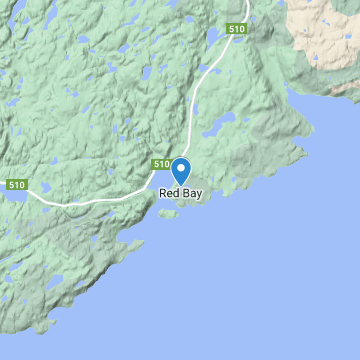Town of Red Bay

Known as Baie Rouge in the 18th century, Red Bay is the best natural harbour in the region and was attractive to European whalers, fishermen and traders since the 1500s.
Indigenous People
Indigenous people lived here for millennia before the arrival of the first Europeans. Evidence of the earliest occupants, dated some 9,000 years ago, is found on high terraces around the harbour, far above the current shoreline. At that time the sea level was significantly higher and the harbour must have appeared quite different from today.
Historical documents indicate that Inuit people were at Red Bay when Basque and French merchant ships first travelled to the coast. These Inuit had migrated south along the Labrador coast, from communities in the north. Another people, of Algonquian descent and related to cultures in Canada's Eastern Woodlands, were also present. In Labrador today these people are known as Innu.
The relationship between European whalers, fishermen & traders and Indigenous people seems to have been amicable, without the violence seen at other, nearby regions. 16th century Basque documents tell of Indigenous people being employed at their whaling stations. Recent linguist research has identified words of Basque origin in the Inuit vocabulary. Archaeology at Red Bay provides strong evident of trade between Indigenous people and French fishermen-traders in the 17th century.
Today about 25% of the Red Bay population identifies as Indigenous. Many share a mixed European and Inuit, or Innu, ancestry.
16th Century Whaling
In the 1500s Basque merchants outfitted trans-Atlantic ships to pursue a commercial whale hunt in the waters near Red Bay. Each whaling ship established a station on shore, with a tryworks, a cooperage and wharf frontage. Whales were hunting using the ship's whaleboats. After a kill the whale was towed back to the harbour where its blubber was removed and brought ashore for rendering to oil at the tryworks. Full barrels of oil were loaded aboard the whale ship anchored in the harbour, for return to the Basque country.
Whale oil was highly valued in Europe where it was used for lighting, as a high grade lubricant and in manufacturing. Red Bay thrived as a whaling port throughout the 16th century. The industry eventually failed, likely because of over-hunting of the whale population.
17th Century French Fishing & Trading
After the Basques came French fishermen & traders. In 1715 Red Bay was on the eastern edge of the Seigneurie du Grand St Modet, a 90-mile stretch of coastline controlled by Pierre Constantine. Historical documents identify a Constantine post at Baie Rouge. In the late 1980s MUN archaeologists found the remains of this post, deep in the inner harbour near the mouth of a stream. Amongst the artifacts found were trade beads: small glass beads used specifically in trade with indigenous people. In exchange for these beads the French traders received a rich harvest of furs including mink, beaver, otter and more.
English victory in the Seven Years War between France and England ended the French presence on the coast. English merchants assumed control of the regions rich resources.
18th century Ship Fishery and Settlement
At first operations were seasonal, with voyages setting out from England in early summer and returning in the fall. They harvested the rich codfish resources of Labrador's coastal waters. A few people stayed on, choosing to over-winter in the new world. Their scant numbers grew gradually, then swelled with a wave of immigrants in the 1840s. Another wave followed in the 1860s.
Many of the newcomers came from Newfoundland. Key Newfoundland centres grew in population and economic importance and the trade with Labrador ports shifted to there. The centuries-old trans-Atlantic trade dwindled and died.
By the 1890s Red Bay fishermen-settlers were poor and perennially in debt to the merchants that controlled the financial credit system of the time.
The Red Bay Cooperative Society
Dr Wilfred Grenfell came to the coast of Labrador in 1892 on behalf of the Royal National Mission to Deep Sea Fishermen. His job was to assess the living conditions and needs of remote fishing communities in Labrador and northern Newfoundland. His findings changed his life, and the lives of the people he served.
The fishermen of Red Bay experienced a particularly bad year in 1895. According to Grenfell, they were very discouraged by their poor catch when he arrived in the community late that summer; they felt that they could no longer survive in the Labrador coast.
Red Bay fishermen, along with fishermen of all the coves and bays, were in a cycle of indebtedness to the merchants who bought their fish and provided all the necessities to survive. A por catch exacerbated the problem.
Grenfell introduced the concept of the cooperative system to the fishermen of Red Bay in 1895. William Y. Pike, one of the few fishermen who could read and write, became a local champion of the idea. The Red Bay Cooperative Society came into existance in August 1896. Red Bay fishermen pooled their financial resources and collectively were able to participate fairly in the local financial market. The Red Bay Co-op existed until the 1940s and helped Red Bay survive when times were lean.
Archaeology
In the mid-1970s historical researcher Selma Barkham discovered a trove of documents related to 16th century Basque whaling and fishing in the region of southern Labrador. Barkham pinpointed Red Bay as a focal point. The news was shared in academic circles and caught the attention of Dr James A. Tuck, head of the archaeology unit at Memorial University. References to a shipwreck brought interest from Robert Grenier, head of underwater archaeology at Parks Canada.
A small team was assembled and travelled to Red Bay in the summer of 1977. Tuck found deposits of fragmented red earthenware roof tiles together with stoneworks and burned sea mammal fat at several locations. Following a grid system, a Parks Canada diver towed on the surface behind a speed boat examined the harbour bottom. Near shore in about 25 feet of water diver Bruce Bennett founds the remains of an ancient shipwreck.
The next year, 1978, research continued and both parties began to ramp us for a large project. Tuck secured funding for a large-scale, multi-year project. He also forged a partnership with the Canadian Conservation Institute (CCI) which specialized in the conservation of historical artifacts, a critical component of the archaeological work. Grenier needed better access to the underwater wreck for close study. A barge was towed to Red Bay and anchored over the wreck site. It became the dive platform and operations centre for the underwater work.
A decade of research followed. As the story unfolded it received increasing attention far beyond Red Bay. In 1985 it was the cover story for National Geographic magazine. The Government of Canada designated Red Bay a National Historic Site and then, in 2013, the United Nations declared it a World Heritage Site. Along with the increased recognition came people. Red Bay became a key focal point for a new & growing heritage tourism industry along the southern Labrador coast.










